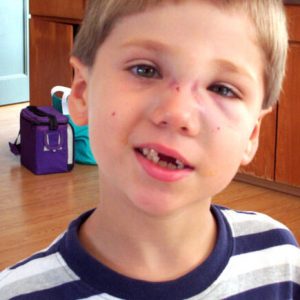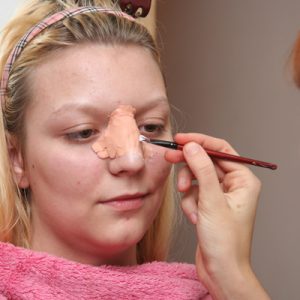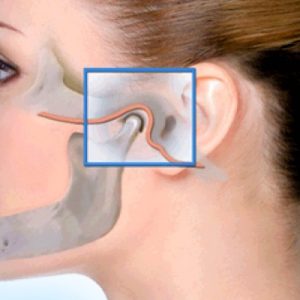Fracture of the nose (or nasal fracture) is a violation of the integrity of his bone structure, which occurred due to mechanical injury. In fact during such a fracture may suffer not only bone, but also the cartilaginous elements of the nose.
Tissue in this localization is literally riddled with a large number of nerve endings, and small vessels, so a broken nose is accompanied by soreness and bleeding.
This pathology is a common cause patients to plastic surgeons.
General data
Fracture of the nose occurs in practice, clinicians often. This is due to the location of the body (he was in favor of the General outlines of the facial part of the skull), as well as the delicacy of its bony and cartilaginous structures. For this reason, the fracture of the nasal bones confidently takes the first place among other traumatic lesions of the facial skull.
Pathology is most often diagnosed in children and younger men mostly in the age group of 7 to 30 years. This pattern has a purely social background: youths and young males often engage in a power showdown, in which and get whacked in the nose – the lion’s share of these “Boxing” confrontation leads to a fracture of the nose. Men are treated in the emergency room for a fracture of the nose three times more often than women.
In children the peak of trauma to the structures of the nose falls between the ages of 7 and 12 years. Boys suffer more than girls, but in recent years there has been a trend toward increasing trauma adolescent girls, due to the tightening of relations in children’s groups.

In children in the first years of life fractures of nasal bones are rare – this is due to the elasticity of bones.

In the older child (7 years) may be a suture between the nasal bones without breaking their integrity.
The number of cases of domestic trauma of the nose, accompanied by his fractures, and in children and adults increases slightly in the summer. In children it is associated with summer holidays, no school and the weakening of parental control.
In most cases, a nose fracture is a closed injury occurs in only 20% of all diagnosed cases, there is violation of the integrity of skin that covers the external nose.
Reasons
The immediate cause of fracture of the nose is straight, less side impact in its structure.
Traumatic damage of bones and cartilage of the nose is:
- unintentional;
- conventionally, unintentional;
- intentional.
Unintentional trauma possible:
- at home;
- in the workplace.
In life there are the following situations that can lead to fracture of the bones and cartilage of the nose:
- the fall of man on the nose – it can occur as a result of loss of consciousness, epileptic seizures, and pronounced intoxication or disorder because of taking drugs;
- the fall of man bulky items. This reason rarely leads to the development of described pathology (subject or should fall sighting, or be massive and heavy), but such cases of trauma is also encountered in clinical practice;
- injury due to careless behaviour (for example, during the playful games of the house or the collective pleasure of moving party) and the funny situations (striking with foot or hand while sleeping sleeping nearby).

In children cause of fracture of the nose is often a fall during active play – especially in locations with hard surface (e.g. asphalt), which are not suitable for children to play.
Occupational injuries as a whole and a broken nose in particular often occur because of safety violations. Most of this trauma is subject to:
- builders;
- agricultural workers;
- locksmiths.
Fracture of the nose in a production environment is often observed due to:
- falling from height;
- attacks from animals. The maximum in the majority of cases people have suffered from sudden strong blow of a horse’s hooves in the face and struck in the nose;
- into the nose loose from the machine and flown away parts.
Unintended causes of broken nose include accident – during these fractures of the nasal bones are observed at the windshield or front panel car interior.
Conventionally, unintentional trauma of the nose, which leads to its fracture occurs when any power sport – particularly if it involves the presence of an opponent. Most often it is:
- Boxing (especially with loyal rules, almost legitimate allows literally to beat the opponent – for example, Thai);
- different types of wrestling.
Fractures of the nose also is fraught conventionally, power sports, which is not expected of the power of influence, but in fact it could not be avoided, as well as sports that do not to avoid falls. This:
- football;
- volleyball;
- basketball;
- gymnastics
and others.
Intentional injury with formation of fracture of the nose, most often triggered by conflict situations and as a result, the solution of controversial questions by using physical force.
In such cases, with a broken nose received in the emergency room after:
- fights;
- beating defenseless or weaker people.
The fracture occurs most often when exposed to the nose:
- solid objects like bats, sticks, and other improvised “melee weapons”;
- feet;
- elbows;
- head (punch it in the nose – a very popular technique in fights).
Most often, social conflicts lead to the fracture of the nose:
- criminal elements;
- prisoners;
- socially disadvantaged adolescents and youth;
- family members who are exposed to domestic violence.
To include intentional trauma during the fighting – there are so-called military grass (including fractures of the nose).
In addition, the study by a number of factors, against which the bone and cartilage of the nose becomes more sensitive to the traumatic impact. Factors such as:
- pathology of blood vessels;
- diseases of the blood;
- endocrine diseases;
- metabolic;
- some infectious diseases;
- some types of pathology of bone tissue;
- chronic, long flowing disease.
The weakness of the bone tissue of the nose (and thus, prone to fractures) may occur in certain pathologies of the blood vessels. This:
- congenital hypoplasia of the arteries and veins;
- hemorrhagic vasculitis – inflammatory aseptic (non-infectious) disease microvascular dilation
and others.
The involvement of these abnormalities to easy occurrence of fracture of a nose is that a disturbed blood supply of the bone and cartilaginous structures of the nose that do not get enough oxygen and nutrients, causing become weak.
Of all the diseases of blood development of fracture of the nose can help:
- different types of anemia – blood diseases with reduction of quantity of erythrocytes and hemoglobin;
- leukemia – pathology of the hematopoietic system, accompanied by insufficient production of normal blood cells.
The involvement of such diseases to the described pathology is that disturbed nutrition of the bone structures of the nose, as a result happening her weakness and reduced resilience in relation to traumatic factor.
The deterioration in the ability of normal tissues to regenerate and replace old on new nlatok observed in the endocrine disorders such as diabetes – impaired breakdown of carbohydrates caused by the scarcity of the hormone insulin.

Similar violations are observed in the pathology of the metabolism of proteins and fats as well as vitamins (particularly vitamin D).
Illustrative example of destruction of bone tissue on the background of infectious diseases is its destruction due to tertiary syphilis. The bone structure of the nose undergo changes at the tissue level, and this contributes to their fractures, even if the traumatic factor is not too pronounced.
Pathology of the bone tissue can also lead to its depletion, which is the weakening of bone structures.
Such processes can be observed on the background of such diseases and pathological conditions, such as:
- lack of vitamin D can cause deterioration of the metabolism of calcium, which also hurts the strength of the bones;
- osteoporosis – increased fragility of bones because of a lack of calcium;
- degenerative changes in the bone tissue is its destruction, which occurs because of a number of pathological factors, other than traumatic.
Chronic, long-term current pathology play an indirect role in the occurrence of fractures of the nose.
Their background can occur atrophy and fragility of bone structures (including the bones of the nose), which contributes to the appearance of their fractures. Is the following pathology:
- malignant cancers;
- hypovitaminosis – lack of vitamins (a and D);
- malnutrition – weight loss due to poor nutrition;
- the pathology of the intestine (it absorbed vitamin D);
- chronic poisoning with poisonous industrial substances
and others.
The development of the pathology
Depending on whether the described pathology damage to the skin of the external nose, nasal fractures are:
- closed without damaging the skin;
- open – with skin damage.
Russian otolaryngologists when dealing with fractures of the nose, use in their clinical practice classification Volkov. According to her nasal fractures are:
- without displacement – such fractures are regarded as the easiest, while in the long term change the shape of the nose does not occur;
- offset – occur when strong traumatic impact. If you have not carried out a reduction (displacement of bone fragments, to resume normal shape of the nose), it can cause deformity of the nose, which often requires plastic correction;
- damage to the nasal septum. It can be stand-alone or be combined with a fracture of the nasal bones and neighboring structures.
After applying a physical force to the nose are possible:
- the occurrence of isolated fracture of the nasal bones;
- its combination with damage to bone structures, which are in the neighborhood.
In the latter case, a broken nose can be combined with fractures of such structures as:
- the walls of the sinuses;
- the frontal processes of the maxillary bones;
- Coulter;
- turbinate;
- wall of the orbit;
- wall ethmoid bone.
All of these structures nasal fracture is most often combined with the trauma of the walls of the paranasal sinuses and the frontal processes of the maxillary bones.
With the combination of nose fracture with a fracture of the ethmoid bone may experience significant bleeding, the cause of which – traumatic injury of the ethmoid artery.
Although small nasal bones, if fractured, can form a large number of small fragments.
If there is a displaced fracture, the bone fragments are among the most likely to shift:
- in the rear direction;
- outwards from the median line;
- inside of the nasal cavity.
If the impact was from below, it may be isolated damage to the cartilage of the nasal septum while preserving the integrity of the nasal bones.
Trauma to the nose may occur, and it is not too intense shock – this occurs if the person:
- already had the facts of trauma to the nose, which after a little time has passed;
- diagnosed with any pathology, against which resistance of bone tissue to the effects of traumatic factor is reduced.
Symptoms of broken nose
Signs that arise from the nasal bone at the time of injury is:
- severe acute pain (up to “stars” in the eyes);
- crunch (hear it some patients);
- bleeding;
- the violation of the form of the nose;
- soft tissue swelling;
- cyanosis;
- subcutaneous emphysema;
- mucus;
- violation of nasal breathing.
The amount of bleeding depends on the degree of the lesion of small vessels in the soft tissues of the nose.
Violation of the shape of the nose is observed when displacement of fragments of bones.
Soft tissue swelling develops very quickly since the injury. To swell can:
- nose;
- ever.

Swelling is accompanied by the characteristic cyanosis parcel data.
Subcutaneous emphysema occurs when the rupture of the nasal mucosa. The phenomenon is that some portion of the air into the tissue, there is a kind of “bloat”.
Mucus are observed as a reaction to the fact of the mucosa to trauma.
When fracture of the nose, frequent phenomenon is the violation of nasal breathing. It is due to such factors as:
- soft tissue swelling of the nose;
- the repositioning of bone fragments.
Pain syndrome subsequently saved, even at the slightest touch to the nose the pain increases sharply. If a broken nose is a fracture of the skull base, can be observed liquorrhea – the expiration of cerebrospinal fluid from the nasal passages. If there are nausea and dizziness, should be suspected brain concussion.
Diagnosis
The diagnosis of fracture of the nose put on the basis of the patient’s complaints, details of anamnesis (it certainly appears a fact of trauma of the facial part of the skull), the results of additional research methods (physical, instrumental, laboratory).
The results of the physical examination the following:
- on examination – marked swelling of the soft tissues (with the spread on the eyelids) and blueness of the skin in the nose (in severe injury possibly bleeding in the conjunctiva), the violation of symmetry, and in severe fracture – significant curvature. With an open fracture detected violation of the integrity of the skin, traces of blood or continued bleeding;
- palpation (feeling) – marked tenderness injured area (even a superficial probing), deformation, displacement of the fragments (their “rolling” under the skin), also on palpation evidenced by swelling of the soft tissues.
The diagnosis of this pathology is easy to put on the basis of complaints, anamnesis and physical examination. But additional research methods are also applied to assess violations that occurred during the fracture of the nasal bones, and related disorders.
Instrumental methods of investigation used in the diagnosis of this pathology is:
- anterior rhinoscopy examination of the nasal cavity using a nasal mirror and the reflector. Helps to identify damage to soft tissue from the nasal cavity, which could occur due to the impact of fragments of the nasal bones on the soft tissues, the source of the bleeding, rupture of the mucous membrane of the nasal cavity, the violation of the form of the nasal septum, as well as traumatic damage to the nasal cavities;
- posterior rhinoscopy – examination of the nasal cavity from the nasopharynx, which is performed by using a nasopharyngeal mirror, and reflector. Allows you to conduct a more detailed study of the soft tissues of the nose and identify the violation of their integrity, which could not be discovered during anterior rhinoscopy;
- radiography of the nasal bones. Is performed in two projections, frontal and lateral. Using this method confirmed the diagnosis of fracture of the nose, determined by the localization and multiplicity of traumatic bone injury, dislocation of fragments (direction and intensity);
- skull x-ray is done if there is suspicion that the fracture of the nasal bones combined with fractures of the skull base.

Laboratory methods in the diagnosis of fracture of the nose is not informative.
Differential diagnosis of
Differential diagnosis in this pathology are often carried out in order to make sure it is an isolated fracture of the nose or combined with a fracture of the skull base.
The consequences of a broken nose

Complications that can occur when a skull fracture is:
- bleeding is the most characteristic case of combined injury of the nasal bones and the ethmoid bone;
- cosmetic defect;
- hematoma – a limited accumulation of the portion of the blood in the soft tissues;
- abscess – a limited abscess in the soft tissues. Often formed by the suppuration of a hematoma or infection at the wound surface, resulting in an open fracture of the nose;
- phlegmon – diffuse purulent lesions of the soft tissues. Formed under the same conditions as abscess;
- osteomyelitis is a purulent lesion of bone tissue. Develops in severe open fractures of the nasal bones, when there is a danger of the spread of purulent process in the bone structure;
- a deviated septum;
- disorder of nasal breathing;
- rhinitis – inflammation of the mucous membrane lining the nasal cavity. Develops due to violations of nasal breathing, which leads to disruption of ventilation (airing) of the nasal cavity;
- sinusitis – inflammation of the mucous lining of any of the paranasal sinus of the nose (maxillary, frontal, ethmoid, sphenoid).
Treatment
Treatment depends on the severity of the broken nose.
The treatment of fractures without displacement are the following appointments:
- peace;
- painkillers.

When a displaced fracture of the appointment of the following:
- reposition of fragments – they slip, to restore the correct shape of the nose;
- with an open fracture – treatment of the wound surface with antiseptic agents;
- antibacterial drugs – in particular, appointed with an open fracture of the nose;
- painkillers.
After reduction is carried out fixation of the fragments, so they are not shifted. It is carried out by methods such as:
- tamponade of the nose, the middle and upper nasal passages fill tight gauze;
- external fixation of the fragments of gauze or bytovymi rollers, which are fixed by medical adhesive tape.
If at the same time with a broken nose a fracture of the skull base, the nasal bones reposition of fragments is carried out 2-3 weeks after injury.
Can also be performed a rhinoplasty – plastic surgery to restoration of the correct shape of the nose. The indications for its implementation is:
- multisplintered fractures;
- the difficulty or otherwise of holding non-operative reduction;
- re-displacement of fragments of the nasal bones.
Prevention
Prevention of bone fractures of the nose is to avoid situations and circumstances in which there is a risk of trauma to the nose.
Forecast
The prognosis of isolated fractures with the formation of a small quantity of bone fragments is favorable, if done timely treatment.
If bone fragments have grown together incorrectly, there are:
- cosmetic defect;
- deterioration of nasal breathing;
- scarring and adhesions (adhesions) in the nasal cavity, which violated nasal breathing and sense of smell.




Your attitude should be seen as the standard when it comes to this topic.
Gut geschrieben. Echt toll. Danke.